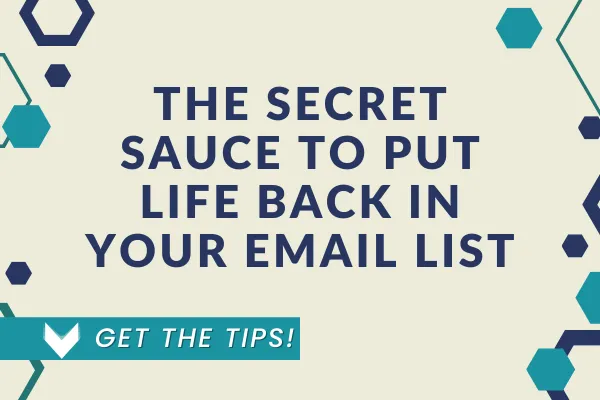

Re-engagement Emails: The Secret Sauce to Put Life Back in Your Email List
Breathing Life Into Your Email List
If you’re in the online business space then it’s likely that at some point or another you realized that your email list isn’t quite popping like it used to. This can happen for any number of reasons so in this post, we're putting the spotlight on a topic that's close to every marketer's heart [but is sometimes ignored]: re-engagement emails.
So why should we care about them? Well, if done correctly, re-engagement emails can be like that old friend who you haven't spoken to in a while, but when you talk, it's like no time has passed at all!
That's right, re-engagement emails can help you win back those wayward subscribers and breathe new life into your email list.
So pick your favorite comfy chair, grab a cup of coffee [or tea, if that's your thing], and let's dive into the world of re-engagement emails!

What Is A Re-Engagement Email?
Honestly, a re-engagement email is pretty much exactly what it sounds like. Picture this: you're having a party [remember those?], and there's that one person standing aloof, off to the side, staring at their phone, not engaging. What do you do? Maybe you walk up to them, start a conversation, and try to engage them, right?
Well, a re-engagement email is the digital version of that. It's an email [or more often a sequence of emails] designed to spark interest among those subscribers who've stopped engaging with your regular emails.
How do you know if you need to run a re-engagement email campaign? It’s all to do with your metrics such as click rate, open rate, etc [more on those later].
In an ideal world, every single subscriber would open every single email and follow on every single call to action. But let's face it, we don't live in a perfect world, and sometimes subscribers start tuning out. A re-engagement email campaign is like that friendly nudge, that gentle reminder saying, "Hey, remember us? We've got some cool stuff you might like!"
What Are The Benefits Of Re-Engagement Emails?
Yes, re-engagement email campaigns are great but why should we invest our time and energy in sending re-engagement emails? Why not just keep sending those subscribers your same newsletter or sales emails? They’ve got to open one at some point, right?
Well, the answer is actually simple: engagement is the crème de la crème of email marketing. That’s not the only reason why, though. There are lots of critical reasons to keep your email list engaged with you. Among these reasons are:
Improving Sender Reputation:
If you're continuing to send emails to people who don't engage with them [or, even worse, have marked you as spam], you could be seriously damaging your email sender reputation.
A good reputation is crucial for ensuring your emails land in the inbox and not the dreaded spam or promotions folder. Re-engaging your inactive subscribers helps keep that sender reputation in tip top shape.
Cost-Effectiveness: Many email marketing services bill you based on the number of subscribers you have [here at Social Fox we don’t penalize you for the size of your list , but, to each their own].
So, if a chunk of your subscribers aren’t active, they can seriously affect your bottom line. By re-engaging them, you either win back a valuable subscriber or gain clarity that it's time to let them go.
Higher Engagement Rate: Here's the thing - it's generally easier to re-engage an existing customer than it is to find a new one. So, by sending out re-engagement emails, you're essentially trying to connect with people who've already shown interest in your brand [and increasing the chances of conversions and engagement in the process].
Keeping Your Email List Fresh: A clean, active email list is a happy email list! By regularly sending out re-engagement emails, you can ensure your list stays up-to-date, and is filled only with subscribers who are genuinely interested in hearing from you.
Having a healthy email list with engaged subscribers is the life blood of any business but this doesn’t happen on its own. You’ve got to be intentional when it comes to your subscribers.
Now we know that getting back in touch with our email list is important so let’s move on to some of the best practices for writing those re-engagement emails campaigns.

How Do You Write A Re-Engagement Email?
Writing a re-engagement email involves intentional reconnection with inactive subscribers. This takes some careful planning and a thoughtful approach to achieve.
As you sit down to draft your next re-engagement email keep in mind these key elements to increase the likelihood of bringing those subscribers back from the brink:
Craft the Perfect Subject Line: Your subject line is the first thing that your subscribers see, and if they've been inactive for a while, you’ll need to grab their attention immediately and ignite that desire to open your email.
Be sure to match the subject line to the content of your email, be concise, and include powerful and engaging words.
You should also try to emulate subject lines that have performed well for you in the past, mirror your customer's voice, and let your brand's personality shine through. Using emojis, numbers, or statistics may be helpful [if that aligns with your brand].
Drawing a blank and need some inspiration? Grab our Re-Engagement Email Guide that includes 50 sample re-engagement email subject lines and has a campaign checklist to make sure you’ve covered your bases before you hit send.
Offer Something of Value: A key part of a re-engagement email is offering your subscribers something valuable to regain their loyalty. This could be a discount code, a freebie, or gated content like an ebook or guide. If your business offers services rather than products, consider offering a free or heavily discounted session as a way to draw people back in.
Clarify Email Preferences: Given that many people receive a lot of emails on a daily basis, it's important to offer your subscribers the ability to adjust and personalize their email preferences and choose the content that’s most important to them. This allows them to control the email content they receive, preventing them from feeling overwhelmed or frustrated.
Be Upfront and Ask: It's important to realize when to let an inactive subscriber go. Despite your best efforts with re-engagement emails, if a subscriber is not interested in your brand, it might be better to focus your energy on capturing new leads who are genuinely excited about what you have to offer.
Make it easy for subscribers to unsubscribe if they wish to do so, and conclude your re-engagement campaign by genuinely asking the reader if they want to stay on your list with a clear call-to-action.
The more ‘on-the-fence’ subscribers you have, the more likely your email sending reputation will suffer for it.
What Are The Metrics For Re-Engagement Emails?
If you’ve never heard the saying "What gets measured gets managed" we’re here to tell you it’s true, especially with re-engagement emails or email marketing in general. If you aren’t tracking specific metrics, you'll never even know if you need a re-engagement campaign in the first place.
Once you’ve written your emails and you send those babies off, keep an eye on the following metrics to know how effective your campaign is and where adjustments might need to be made.
1. Open Rate
This is the percentage of subscribers who opened your re-engagement email. A low open rate could indicate that your subject lines aren't engaging enough or your email is landing in the spam folder. And if you're seeing high open rates? That's a good sign that your subject lines are doing their job!
2. Click-Through Rate (CTR)
The CTR measures the percentage of email recipients who clicked on one or more links contained in a given email. If your CTR is low, it could be that the content of the email isn't compelling enough or the call-to-action isn't clear. A high CTR, on the other hand, indicates that your email content is engaging and effective for your subscribers.
3. Conversion Rate
This is the percentage of email recipients who clicked on a link within an email and completed a desired action, such as making a purchase or filling out a form. It's a clear indication of how well your re-engagement email motivated subscribers to take action.
4. Bounce Rate
The bounce rate is the percentage of your total emails sent that could not be delivered to the recipient's inbox. There are two types of bounces to track: "hard" bounces and "soft" bounces. A high bounce rate may mean you need to clean up your email list. You should also always unsubscribe email addresses that have a hard bounce. Continuing to send emails to those email addresses can really hurt your sending reputation.
5. Unsubscribe Rate
This is the percentage of your recipients who click the "unsubscribe" link in your email. It's normal to see some unsubscribes during a re-engagement campaign, in fact it’s not a bad thing at all to trim the fat of your email list. But a high unsubscribe rate could be a sign that your emails aren't quite landing with your audience.
6. List Growth Rate
This measures how quickly your email list is growing. If you're adding new subscribers at a rate that outpaces the number of unsubscribes and email account closures, your list growth rate will be positive.
By focusing on these metrics, you can gain valuable insights into the effectiveness of your re-engagement campaigns. With an all-in-one marketing system like Social Fox, tracking these metrics is a breeze.
Not only can you manage your email marketing campaigns, but you can also keep an eye on these key metrics in real-time. This allows you to adjust and optimize your re-engagement emails for the best results.
Remember, the ultimate goal isn't just to have a large email list, but to have an engaged and active email list. An engaged subscriber is a valuable subscriber any day!
Need a Little Extra Guidance?
If drafting those emails is feeling a little heavy right about now, no worries! We’ve got your back. We put together a guide especially for this occasion.
Our free Re-Engagement Email Guide gives you a checklist as well as 50 suggestions for email subject lines that are sure to grab your subscribers attention and boost that open rate.
Also be sure to check out our other thoughts on email marketing including our strategies on how to grow your email list.
Let Social Fox Help You...
and ultimately be your business growth partner!

© Copyright 2019 - 2025 Be Inspired Now Media, LLC | All Rights Reserved | Privacy Policy | Terms Of Use
